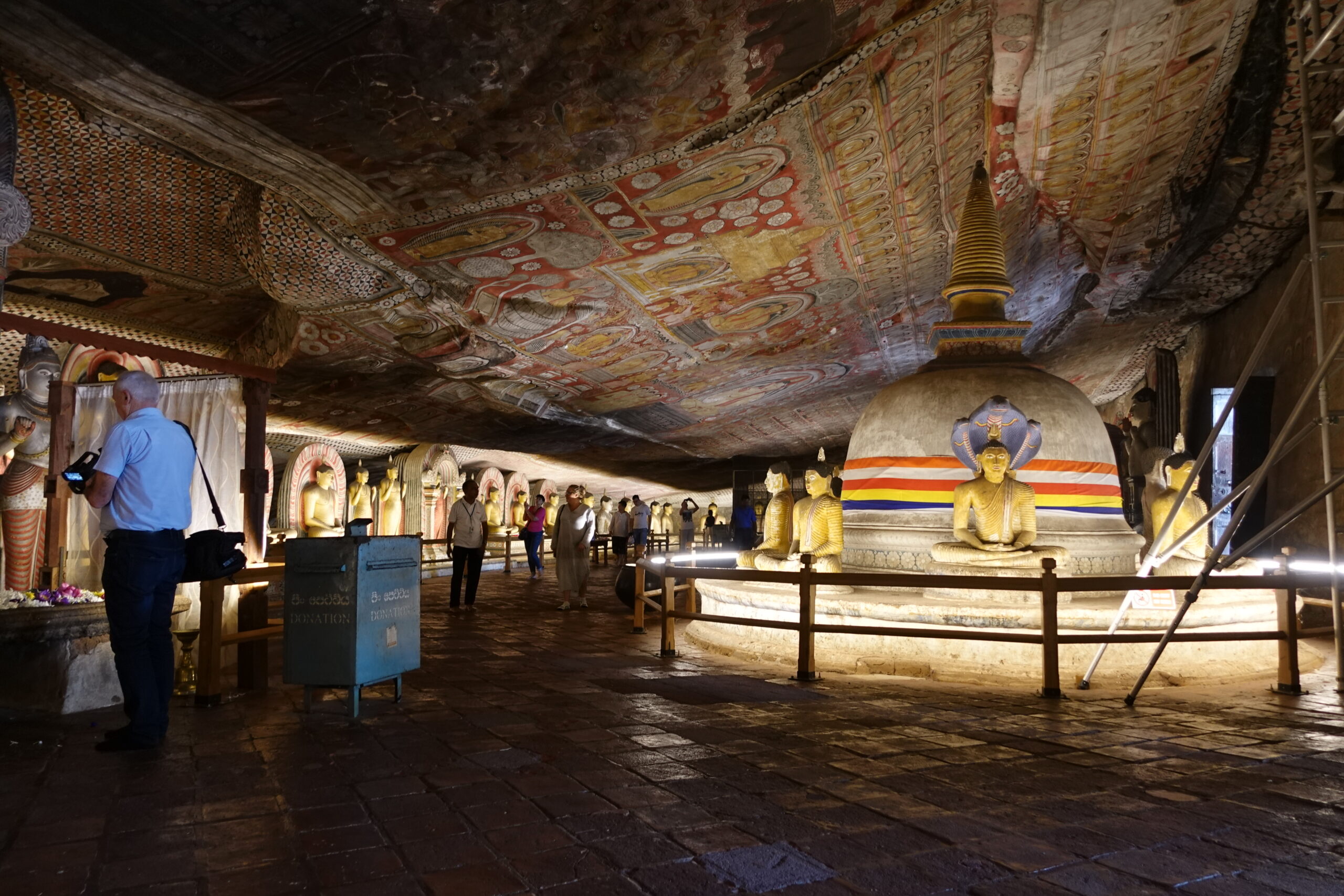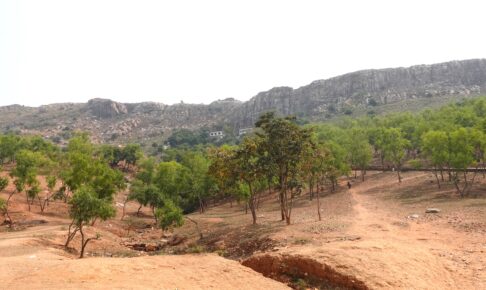Travels to Buddhist sites in India and Sri Lanka (37)
The Impact of Dambulla, a World Heritage Site in Sri Lanka! ~ I will never forget this Buddhist site!
After touring the northern part of Sri Lanka from my base in Jaffna, I headed south at once to my next destination in Sri Lanka.
I am now headed to the Dambulla Cave Temple, a Buddhist site that was registered as a World Heritage Site in 1991.
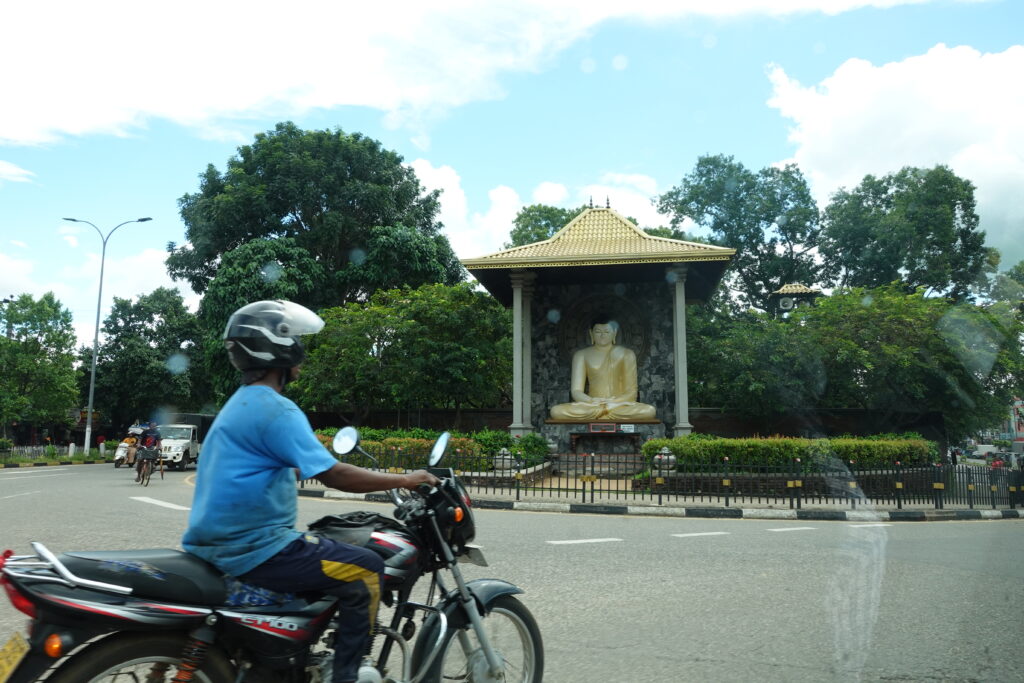
I came here with meal breaks along the way, but it took me 6 hours to get here again today. Sri Lanka is hard.
When I arrived near Dambulla, I saw a large Buddha statue set up in the road square. It was new to see. I have read many books about Sri Lanka, and it is just like in the books. In recent years, Buddha images have been erected not only on temple grounds but also in public places. Sinhala Buddhist nationalism still remains strong. Our guide, who experienced the civil war, complained about the construction of Buddha statues.
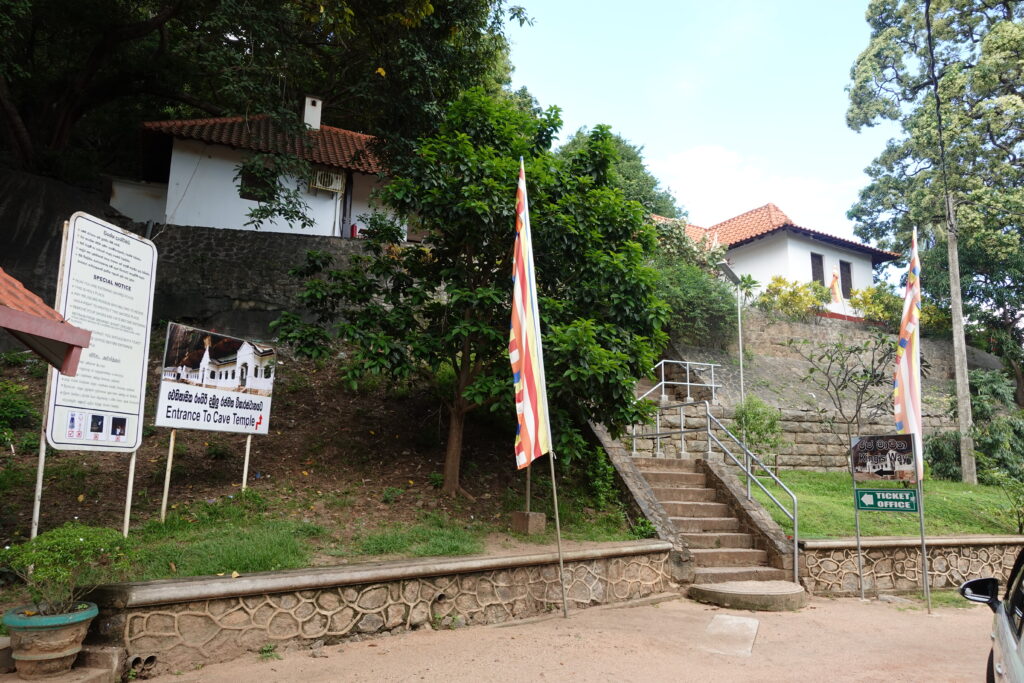
Now, we have arrived at the entrance to the Dambulla Cave Temple. From here, we climb up the stairs to the temple, which is carved into the rocky hillside.
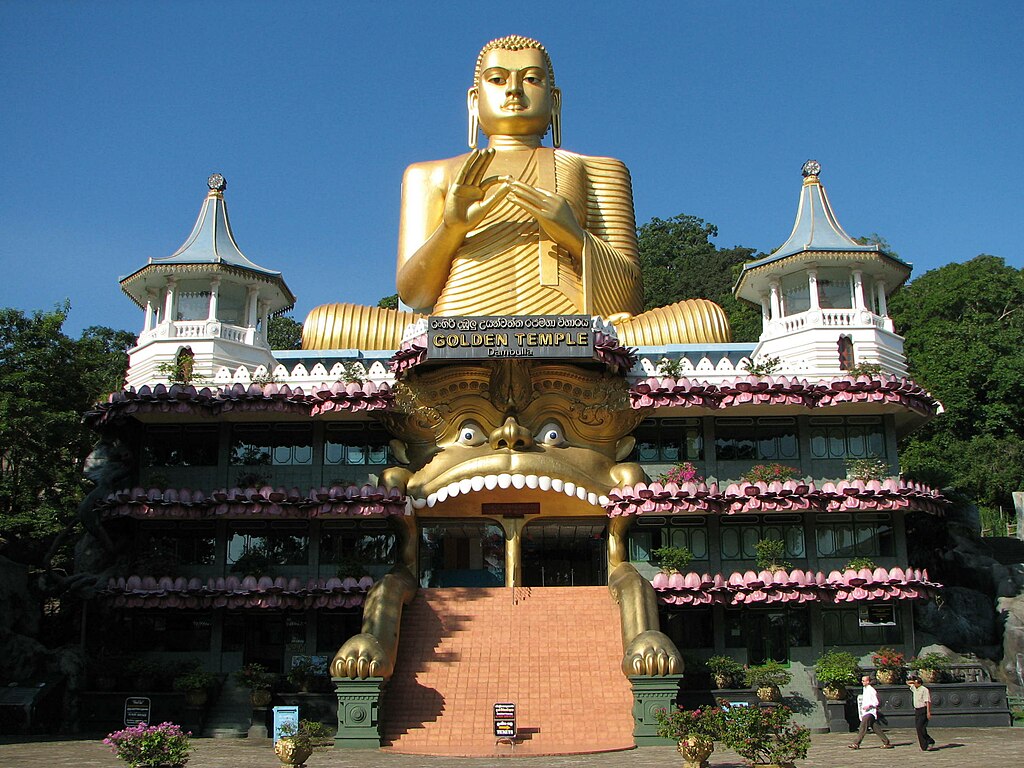
Although guidebooks often refer to the main gate here, we did not enter from here. Our guide told us that he did not recommend entering from here because there were many stairs and it would be tiring.
Besides, I just can't get a sense of the quaintness of this gate, which was obviously built recently. This kind of design does not fit in my context. The guide also said that he did not have a good image of this golden Buddha image. I suppose that is true. It goes without saying that Sinhala Buddhist nationalism and politics are inextricably entwined. After the civil war, there are many Sri Lankans who are angry about such a fact.
In the mass demonstrations of 2022, the people rose up to force President Rajapaksa to resign, and Rajapaksa is also known as a politician who used Sinhala Buddhist nationalism for political purposes. The public already knows that a large amount of taxpayers' money and bribes have flowed into his policies for the promotion of Buddhism.
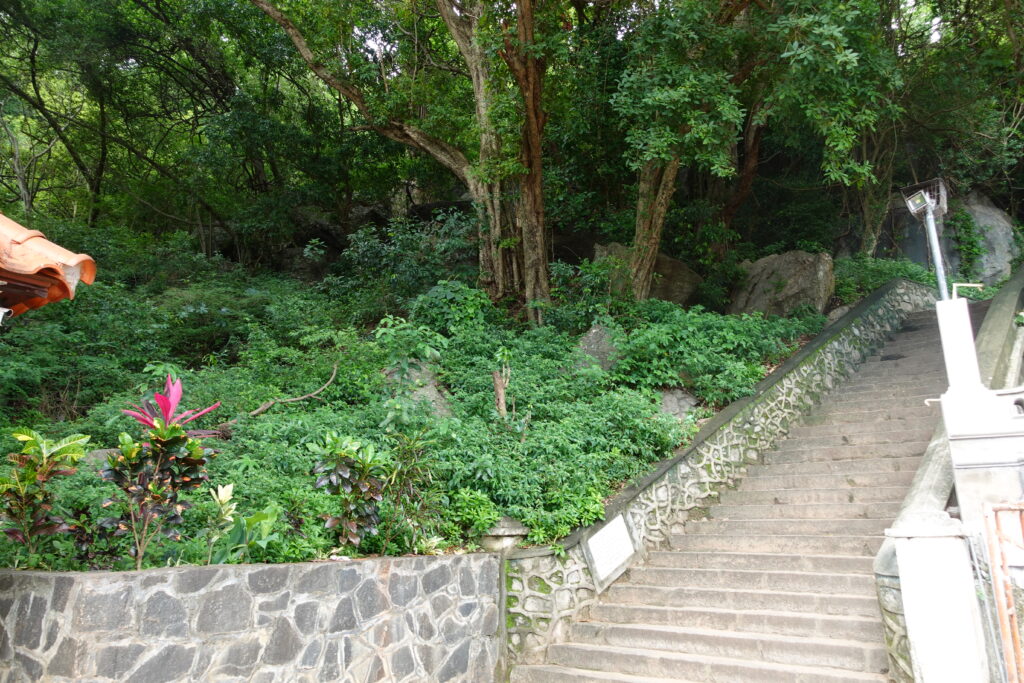
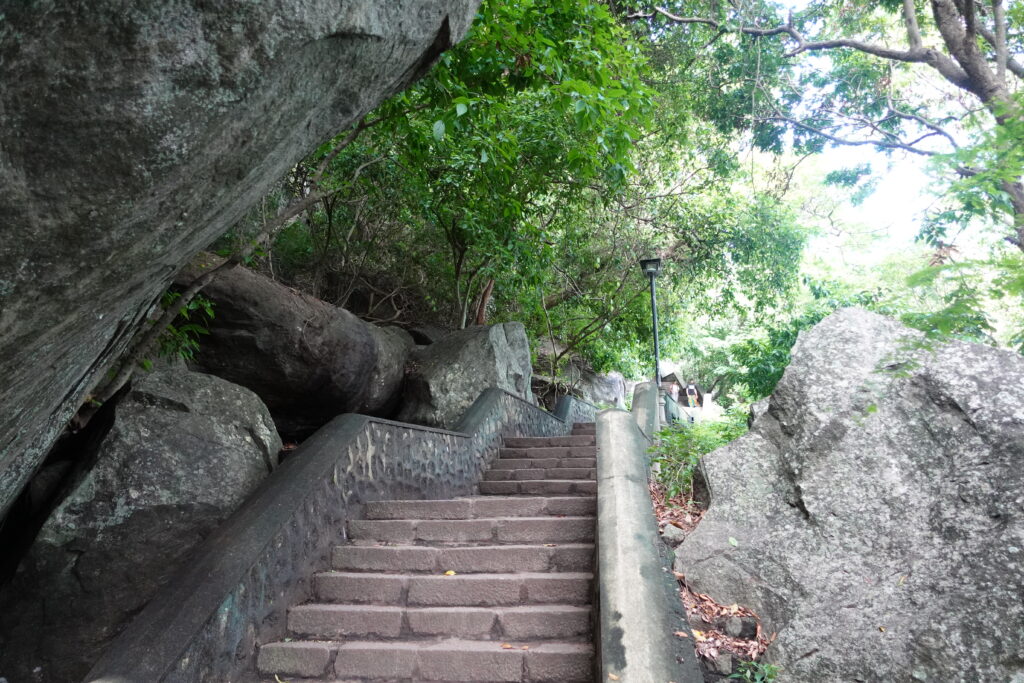
Now, let's go up the stairs.
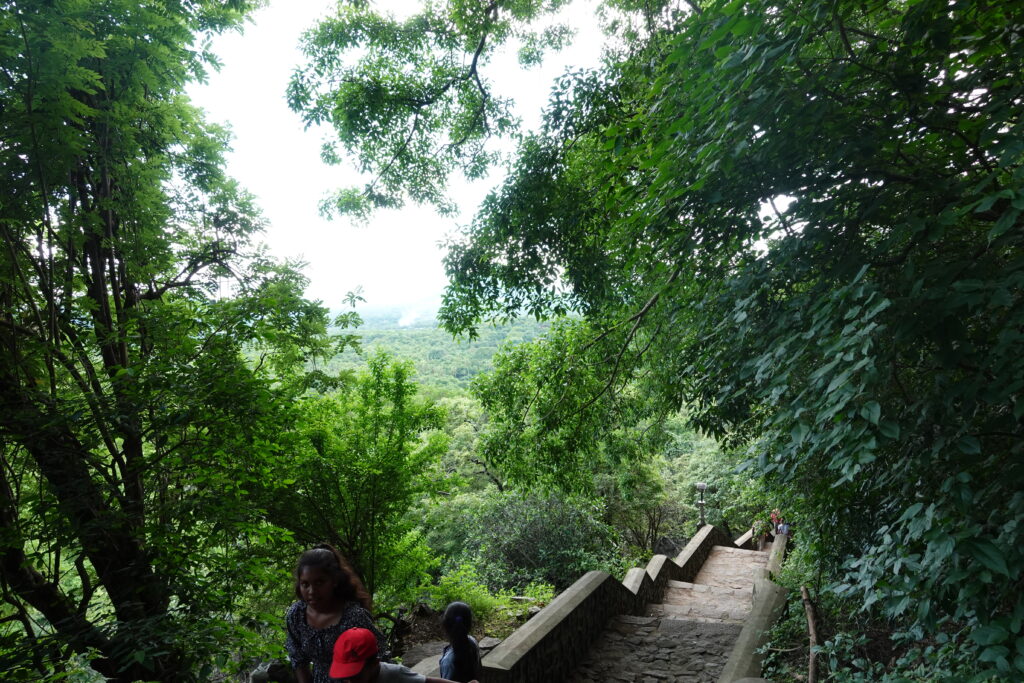
I looked back and realized that I had climbed quite high. It was a good workout.
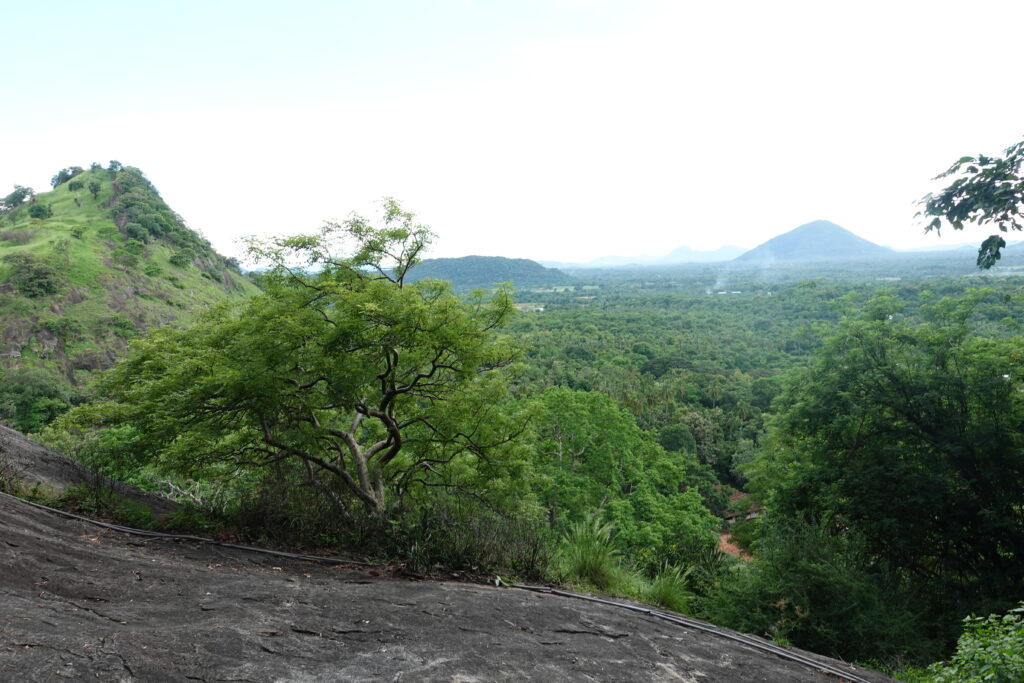
The view is now clear. The view was truly spectacular. Mountains suddenly rising above the deep green plains. This is a great view.
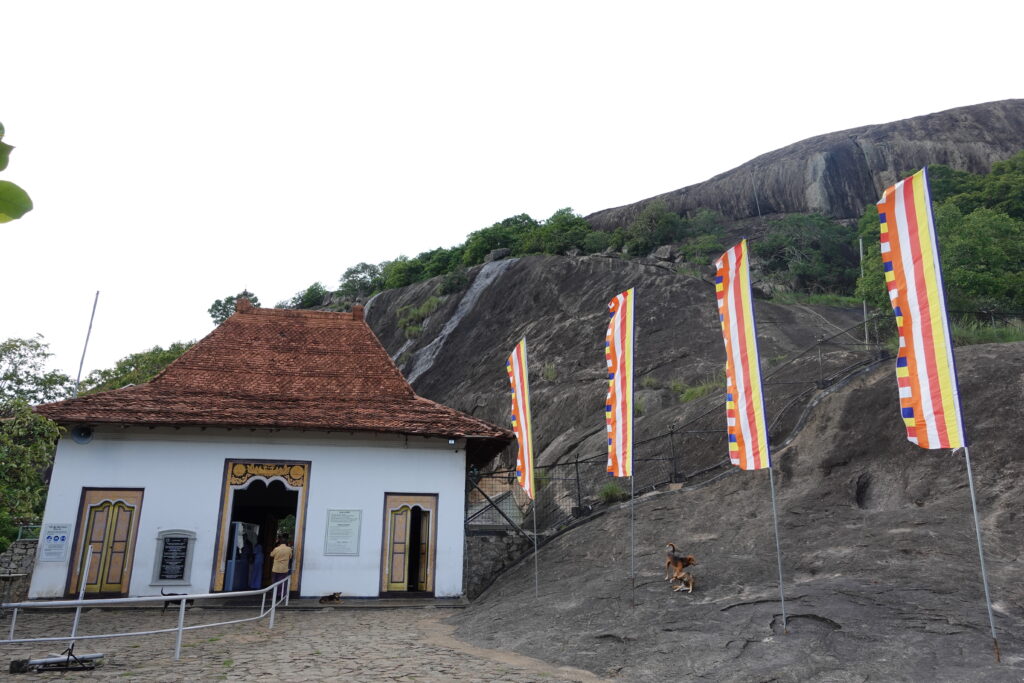
Now, it is time to enter the Dambulla Cave Temple. As it is called a cave temple, it is surrounded by rocky mountains.
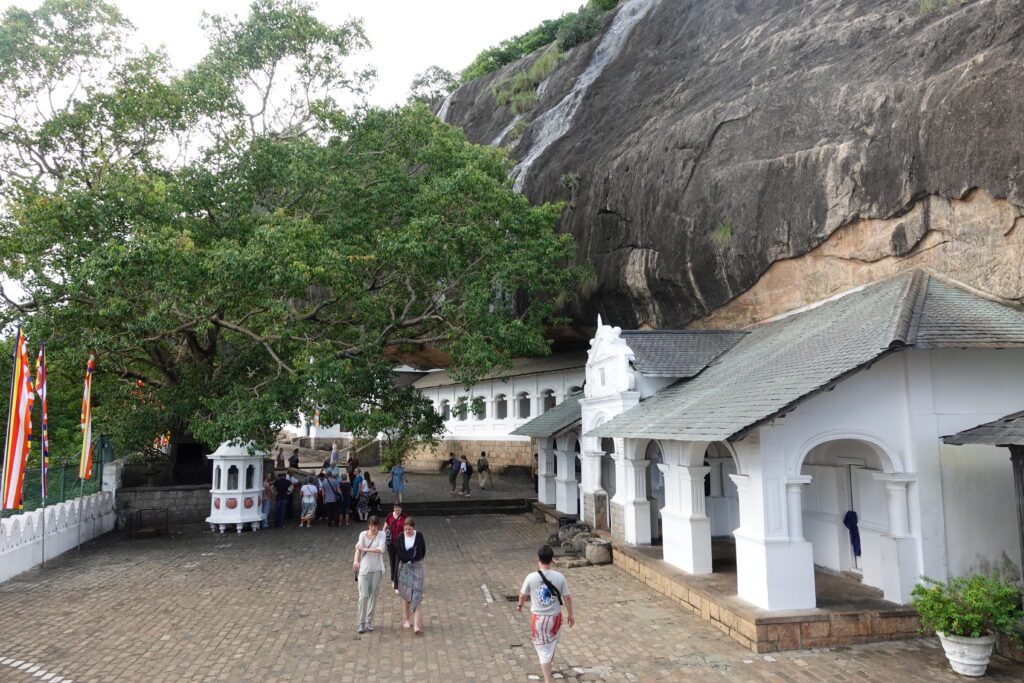
This is the precincts of the Dambulla Cave Temple. The building itself was probably constructed in recent years.
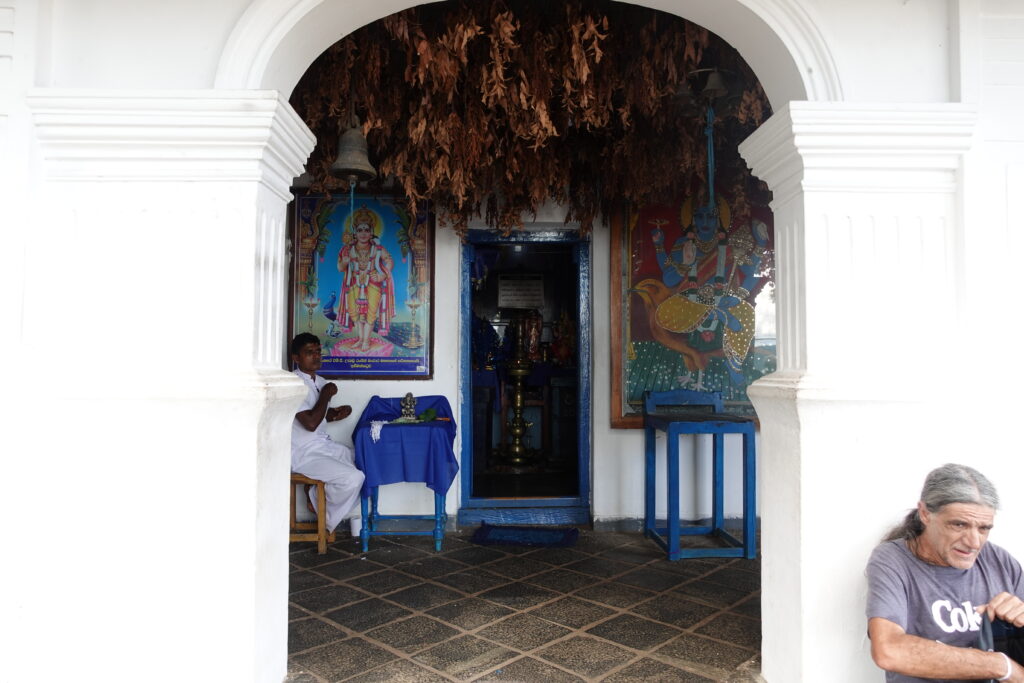
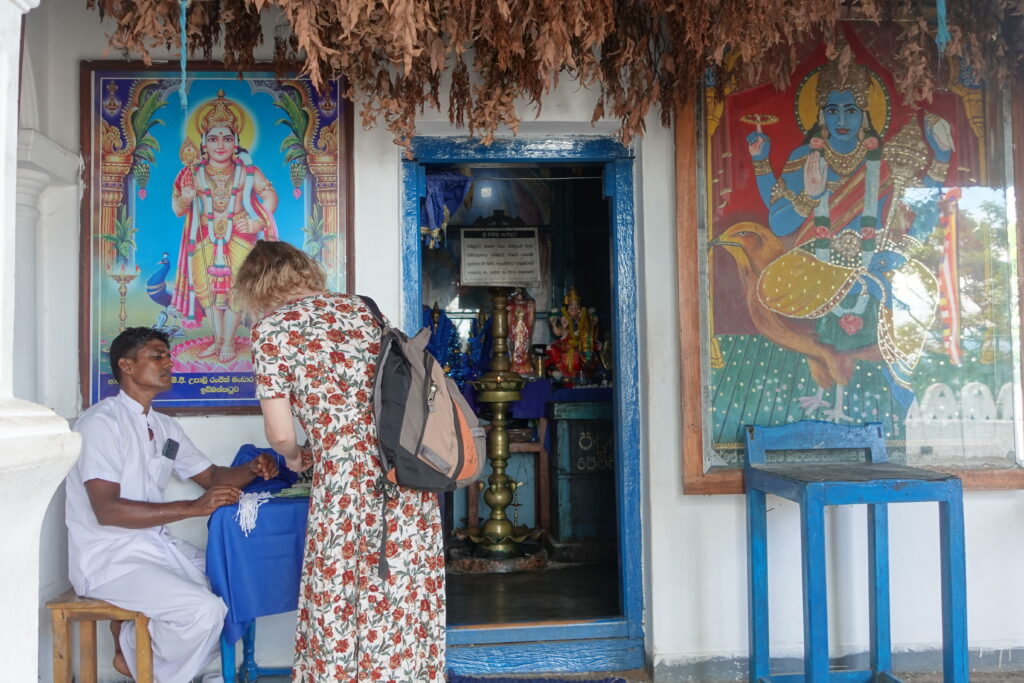
There was a Hindu shrine near the entrance. This rocky hill may have been a place of worship for the Tamils. I do not know the details.
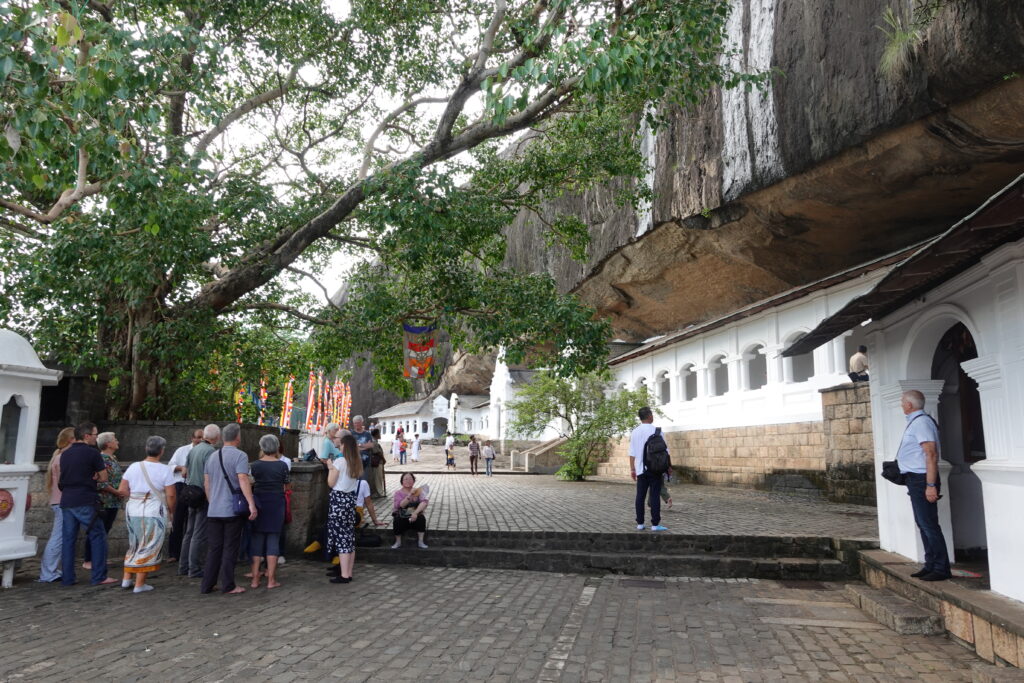
Now, let's take a quick look at this temple before we visit the Dambulla Cave Temple.
Here is a quote from the UNESCO website.
The cave temple, located on a rocky hillside in the center of the Cultural Triangle north of Kandy, has been an object of worship since its opening in the 1st century BC. Cave 1 is known for its 14-meter Reclining Buddha lying with its head to the north. Cave 2, the largest cave, houses more than 50 Buddha images, and its walls and ceiling are covered with numerous mural paintings. Cave 4 was severely stolen, Cave 3 was built in the 18th century, and Cave 5 was opened in 1951.
UNESCOhome page.
And it is "known as the best-preserved cave temple in Sri Lanka. This is how it is often described in guidebooks and on the Internet.
Now, let us actually enter the Dambulla Cave Temples. The first cave we will see is Cave 1, which was opened around the 1st century BC.
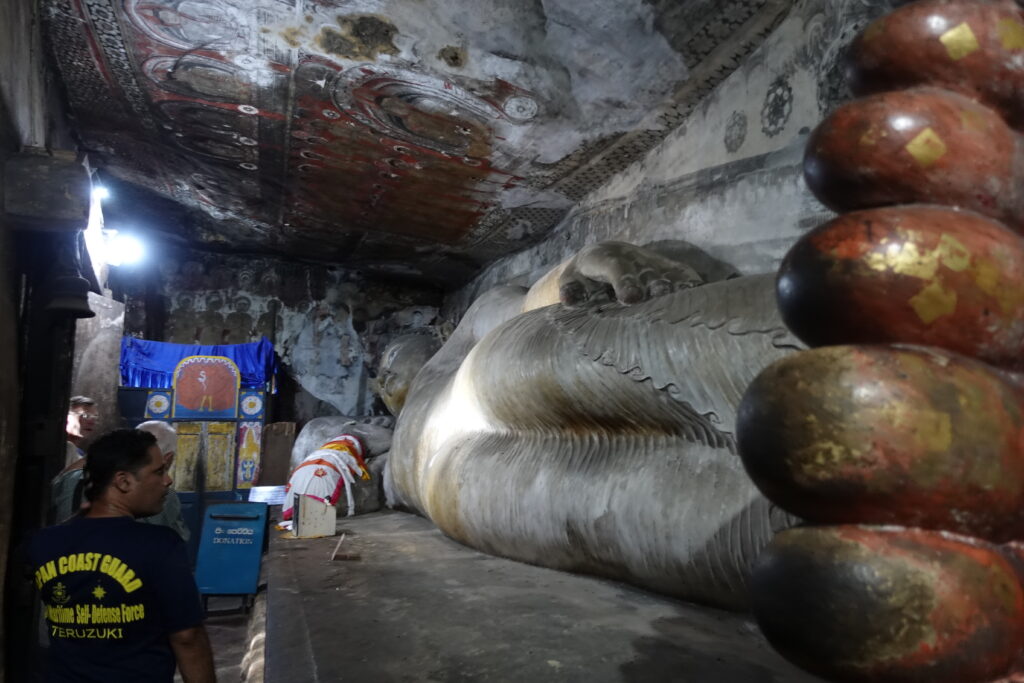
When I entered the hall, I found a huge reclining Buddha enshrined there. The hall is illuminated, so it is not that dark.
In the 1st century B.C., Buddha images did not yet exist. It is said that the first Buddha images in the world were made in Gandhara and Mathura around the 1st century AD. Therefore, the Reclining Buddha must have been made long after the opening of the grottoes. As is the case with other Sri Lankan Buddha images, the exact date of creation of this image is unknown.
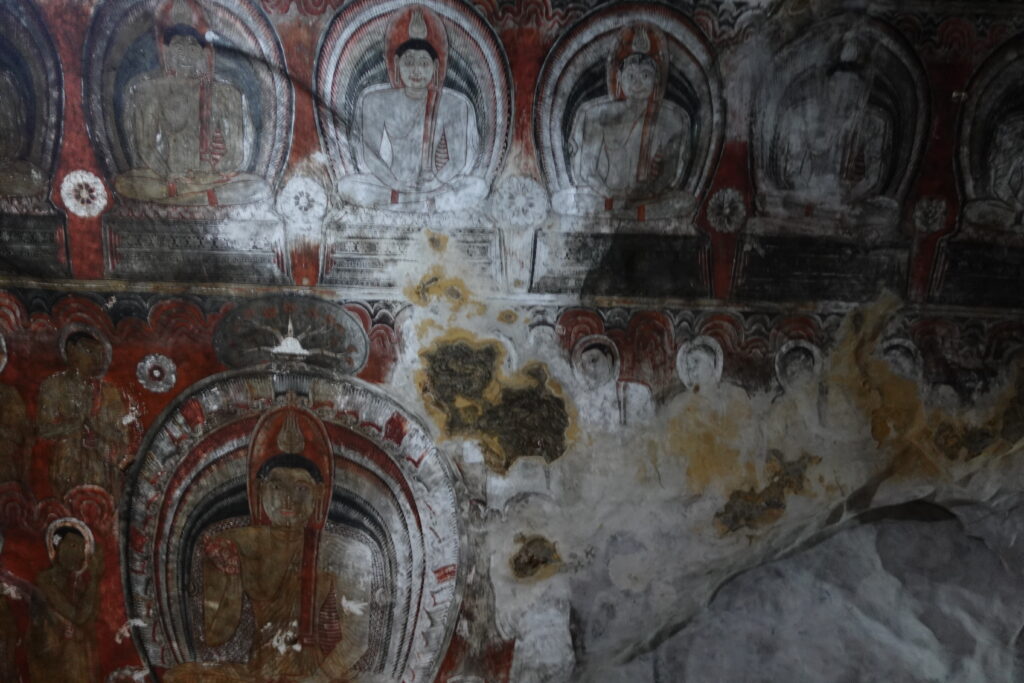
Above the head of the Reclining Buddha, a mural was still visible. The coloring remains quite well, but it does not look as if this is an old one.
And the second cave I visited after this one was problematic. It is that spacious grotto that often appears in guidebooks and advertisements.
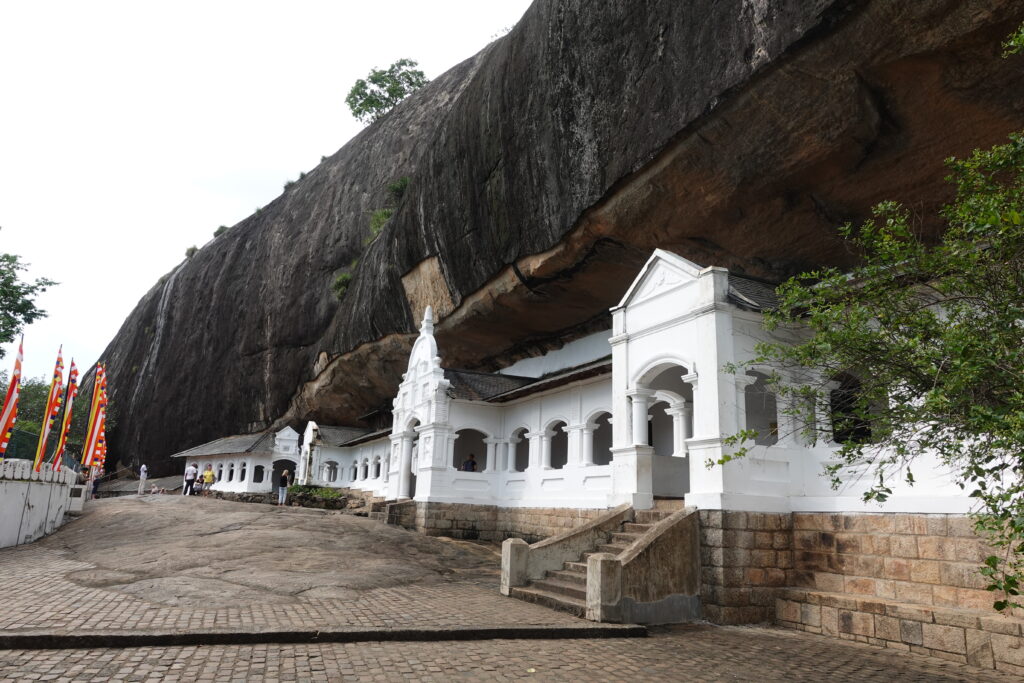
The hall, visible from the entrance, was dimly lit by bulb-colored lights in the dimly lit space, which momentarily heightened my anticipation.
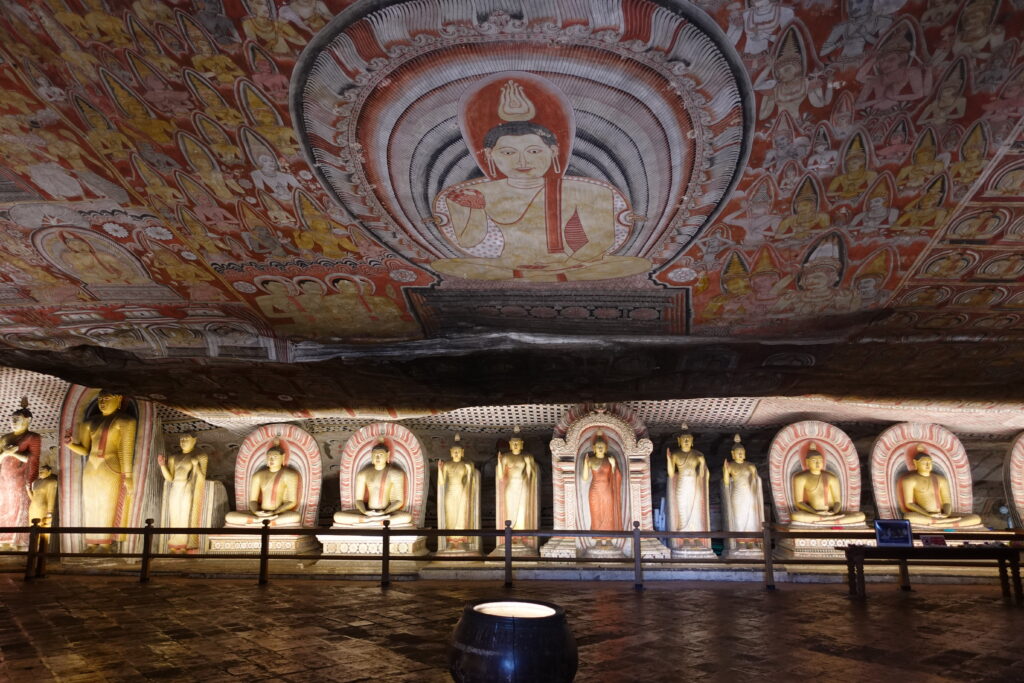
However, I was disheartened by the Buddha statue I saw as soon as I entered the building.
The coloring is not delicate, and there is nothing special about the painting of the eyes or the expressions on the faces.
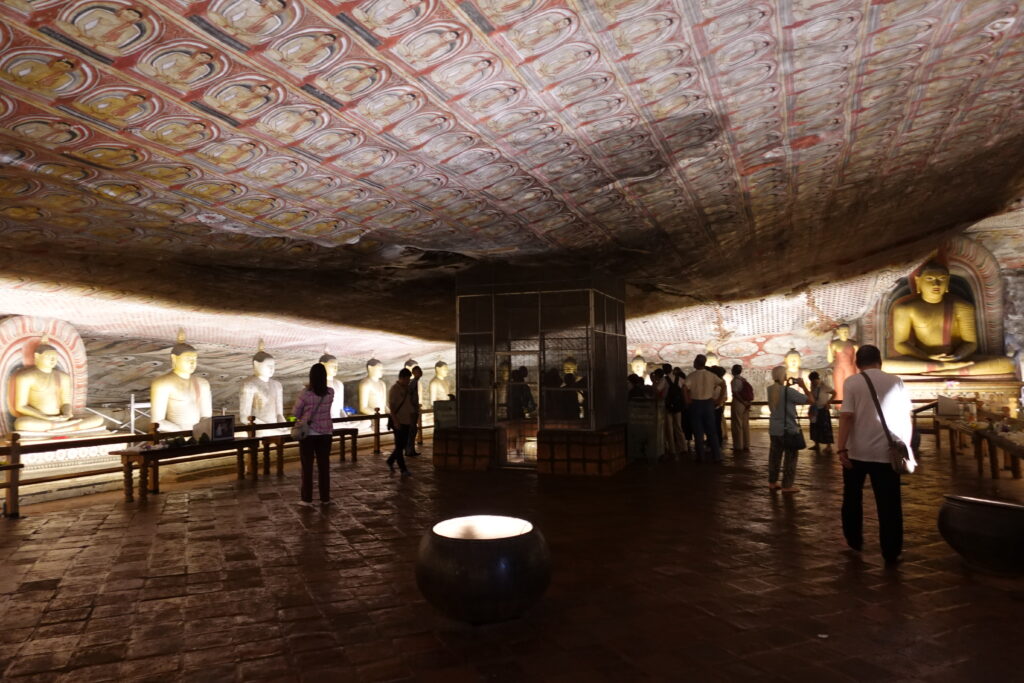
The walls of the grotto were lined with many Buddha images, most of which clearly appeared to have been recently painted.
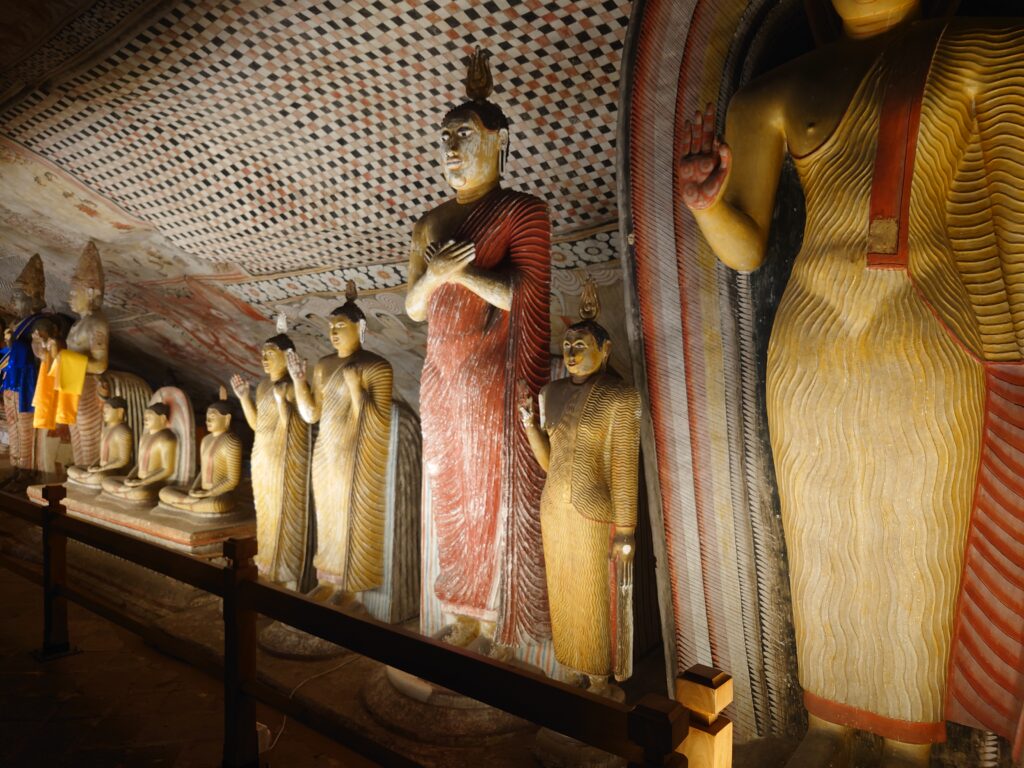
Some of the Buddha statues were so unbelievable that I wondered if I was allowed to put them there. I am well aware that Buddha images are objects of faith, not works of art. However, I still wonder about it. I felt this was too much for me, knowing the history of Buddhism in Sri Lanka.
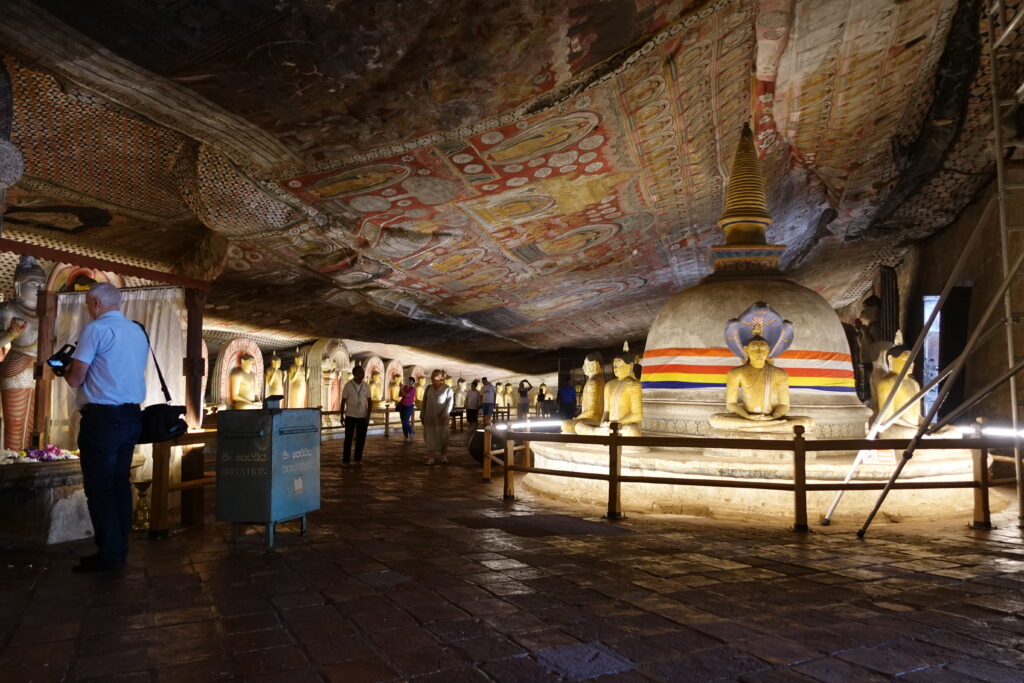
I honestly don't feel any spirituality here, in fact, I even felt the secularity of trying to treat this place as a holy place. I was also bothered by the way it was lit up. I don't blame them for calling it an insta-lighting...

As we saw earlier, these ceiling paintings and murals as well as the Buddha images are clearly new.
I am not saying anything is wrong with new Buddha images or murals.
But I am caught up in the fact that Sinhala Buddhist nationalism, which claims to be preserving tradition, orthodoxy, and the most ancient Buddhism, is this new thing.
What is important to me is whether this Buddhist site has really continued to be worshipped as well.
About the history of this grotto by Teruji ItoAn Introduction to Sri Lankan Buddhist Art.The following is the explanation in the following section.
The cave temple at Dhampra is believed to have existed since the time of this king (King Vadagamani Abhaya, 1st century B.C.E. *blog author's note) and was first modified by him. Thus, the history of the cave temple dates back more than 2,000 years.
Much later, in the 11th century AD, during the reign of King Vijayabahu I of the famous Polonnaruwa Dynasty, the king took notice of the Dambulla Cave Temple and had it restored. This is mentioned in the second chapter of the Chulavantha, the most representative chronicle of Sri Lanka.
Later, the cave temple was restored by King Nissankamalla, also of the Polonnaruwa period. During the king's fourth grand tour, he visited the Dambulla Cave Temple. On the occasion of this memorable visit, he left an inscription, in which he described the good deeds he had done. This large inscription can be seen today between the gate and the first cave. In this inscription, the king restored or made many statues of Buddha, held a big festival, and gave a name to this cave temple. It is called "Svarnagiri Guha," which means "Golden Mountain Cave (Temple).
After that, there is no historical record of the Dambulla Cave Temple, and it will have to wait until the later Kandy Dynasty (around the end of the 16th century to the beginning of the 19th century). According to the Sri Lankan chronicle "Dhampur Wihala Tutapatha" written in 1726, the cave temple was restored by King Senarat (reigned 16004-1635) in the early 17th century. The restoration work took three years, and when it was completed, as many as 65 Buddha images were painted.
Later, King Kirti Sri Rajasinha (reigned 1747-17782), also of the Kandy Dynasty in the late 18th century, made many contributions to the construction of the cave temple. Among these, the most notable work was the excavation of Cave 3, which had been used for storage, and the conversion of Cave 3 into a place of worship as we see it today.
Yuzankaku, Teruji Ito, An Introduction to Sri Lankan Buddhist Art, p.64-65
As this commentary states, there is a lot of "blank time" in Dambulla. It is precisely because of the devastation that "restorations" were made and these are recorded in the chronicles.
(29) Why wasn't I moved by Sri Lanka's holy sites and Buddhist monuments--thinking about religion and the "context of life?"As I mentioned in the article "Sri Lanka," you may have an image of Sri Lanka as a Buddhist country that preserves the world's oldest Buddhist tradition, but in fact, the story is not that simple.
The history of the Buddhist order is that in the 11th century it was almost destroyed, and ordained priests were invited from Myanmar to manage to keep it alive, and in the 18th century the tradition of the order virtually ceased as there were no more ordained priests who could give the precepts.
Dambulla is not unrelated to such historical trends. It is a gray area to say that Dambulla has been a place of worship for more than 2,000 years, as is often the case in guidebooks and other commentaries.
It is written by Yoshio SugimotoThe Legacy of Buddhist Modernism."But they also point out the following
As is well known, Sri Lankan Buddhism is recognized as the most venerable Buddhist tradition, descended from the Southern Theravada tradition. However, just as "tradition" does not necessarily mean historical continuity, the Theravada Buddhist tradition in Sri Lanka had already declined for a time in the 3rd to 5th centuries A.D. due to the influence of Mahayana Buddhism, and the political turmoil from the 12th century onward caused the monastic community to become confused.
The monastery was later restored by Parakramabahu VI (1411-1466), the founder of the Buddhist monarchy during the Kingdom of Kotte (1372-1597), but it began to decline again in the 16th century under the influence of Christianity, and by the 18th century the monastery itself had disappeared. In the 18th century, the monasteries themselves were almost extinguished. In short, Sri Lankan Buddhism today is a re-creation of the Theravada Buddhist tradition, but it is not a direct continuation of the earliest Buddhist traditions.
Some line breaks have been made to make it easier to read on smartphones, etc.
Fudokyosha, Yoshio Sugimoto, "The Legacy of Buddhist Modernism: Anagarika Dharmapala and Nationalism," p. 63.
Historical Continuity."
These words have had a profound impact on my religious context.
(29) Why wasn't I moved by Sri Lanka's holy sites and Buddhist monuments--thinking about religion and the "context of life?"As I told you in the article "The Church in Armenia," that is exactly what I was once puzzled by in the Armenian church.
And here in Sri Lanka, I feel this especially true, since it is the same Buddhism. And since it is a fact that Buddhism has been used for political purposes and has developed into a civil war, I have to be sensitive to the history of Buddhism in this country.
For this reason, I could not help but feel a sense of historical continuity in this Dambulla.
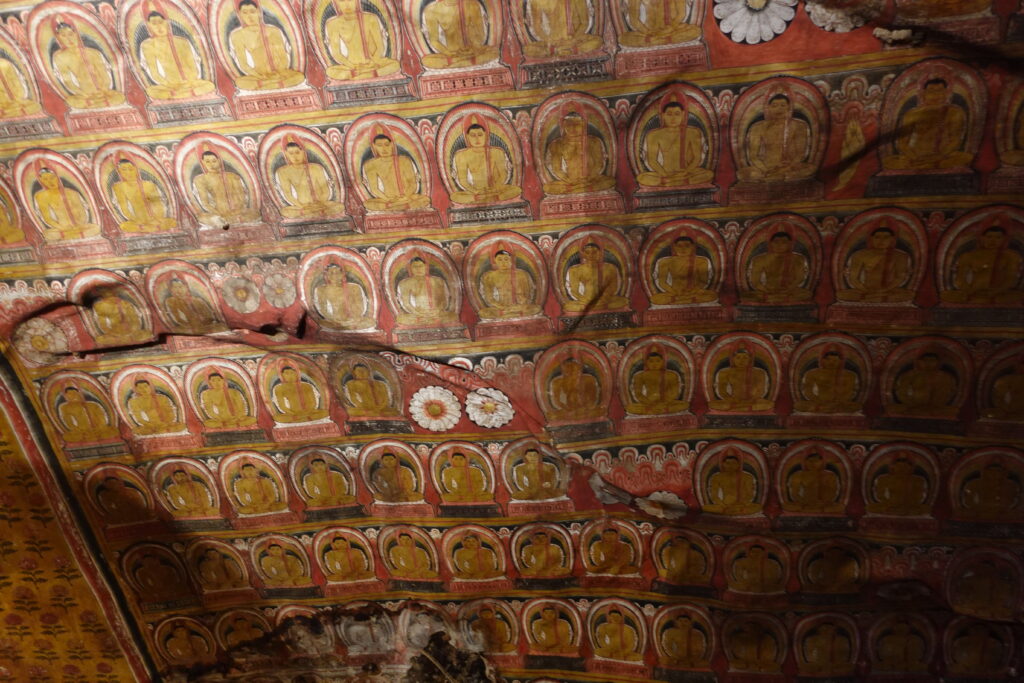
And what I couldn't help but wonder about in this grotto were these ceiling paintings and murals. I couldn't help but ask the guide, "When were these paintings done? When were these paintings done?
The answer came back, "I heard it was restored around the 18th century.
So how am I supposed to react when I am told that "we have the best-preserved mural paintings in Sri Lanka"?
There is also an interesting commentary on this muralAn Introduction to Sri Lankan Buddhist Art.I will present it here because it was written in the following section.
It is not known when exactly the Dambulla murals were painted. It is not known when exactly the Dambulla murals were painted, because once a painting disappeared, it was replaced by a new painting, a new coloring, or a completely new painting. Some scholars believe that the oldest parts of the paintings may date back to the 8th century, and that some of the paintings are similar to those of the famous Sigiriya mural paintings.
However, most of the Dambulla murals we see today are quite distinct from the classical murals we saw in the old Sigiriya and Polonnaruwa periods. In other words, they were painted much later, in the 17th or 18th century. For example, the decorative designs and the representation of trees and vines are stylized and unique. You will notice that this style of painting is separate and distinct from the older mural paintings of the Polonnaruwa period, which are, so to speak, two-dimensional.
In other words, the Dambulla mural paintings are quite new. As I have already mentioned, in the 17th century during the Kandy Dynasty, King Senarat painted the murals of Cave 1, Cave 2, and Cave 4 by the painters of the time. Later, in the 18th century, King Kirti Sri Rajasinghe repaired and modified the murals in Cave 3 and the entire Dambulla by the painters of the time.Yuzankaku, Teruji Ito, An Introduction to Sri Lankan Buddhist Art, p.66
What do you think? I was surprised when I read this passage. The idea here is not to preserve old paintings, but to paint over them when they are no longer good enough.
So there are no old paintings left; those painted in the 17th and 18th centuries are still here today. It is no wonder that they are well preserved.
However, the average tourist has no way of knowing such things. Most of them probably only remember that the murals were painted on stone caves that have existed for 2000 years. This is one of the reasons why I was so bothered by this visit.
Nevertheless, even though Sri Lankan monuments have been rapidly reconstructed and restored through the Sinhala Only policy, some may wonder whether Sri Lankans are not wondering why they have so many new and shiny Buddha images.
Yes. That is exactly what it is. Why are new Buddha images and temples so commonplace in Sri Lanka?
The key is.(30) A Brief Explanation of Theravada Buddhism in Sri Lanka - A Word on its Differences from Japanese Buddhism.It is the concept of "merit" that I spoke of in
If you do good deeds, you will accumulate merits. When merit accumulates, good things happen. This is the basis of Sri Lankan Buddhism.
And at the top of the list of "good deeds" is the building of temples and Buddhist statues. Building new temples and Buddhist statues and donating them to the Order is a way to accumulate great merit and virtues. This is especially true in Thailand, where new temples and Buddha images are being built as the economy grows. The trend is the same in Sri Lanka.
The important point here, however, is that the "construction of new temples and Buddhist statues" is the most important merit, while the merit of maintaining them is not so much considered by the general public. In other words, although it is good to build a new temple, even if one tries to restore it after several decades, people are not very cooperative because it is not "building a new one. Everyone is concerned with how much merit and virtue they can accumulate. The problem is that people tend to seek greater merits and virtues.
Another important point is that Southeast Asian Buddhism favors gilded objects. This is not the case in Japan, where old and blackened objects are much appreciated. As I will talk about later in the article on Buddhist monuments in India, they paint their monuments in gold and in colors of the highest order. That is the merit and gratitude. This is a completely different feeling from that of the Japanese.
In fact, it is not possible to accumulate merit and virtues by preserving old things as they are. This is the norm in our culture. It would be nonsense to bring Japanese sensibilities and norms into this country. If a Sri Lankan were to visit an old Japanese temple, he or she would probably feel as numb as I do. This is a cultural difference. It is not about which one is better than the other. (Besides, as I mentioned above, Sri Lankan Buddhism has declined many times and there are no old Buddhist statues left in Sri Lanka. Furthermore, unlike Japan, where Buddhist statues are made of wood, huge stone Buddhas cannot be moved. (In other words, they cannot be transported in an emergency.)
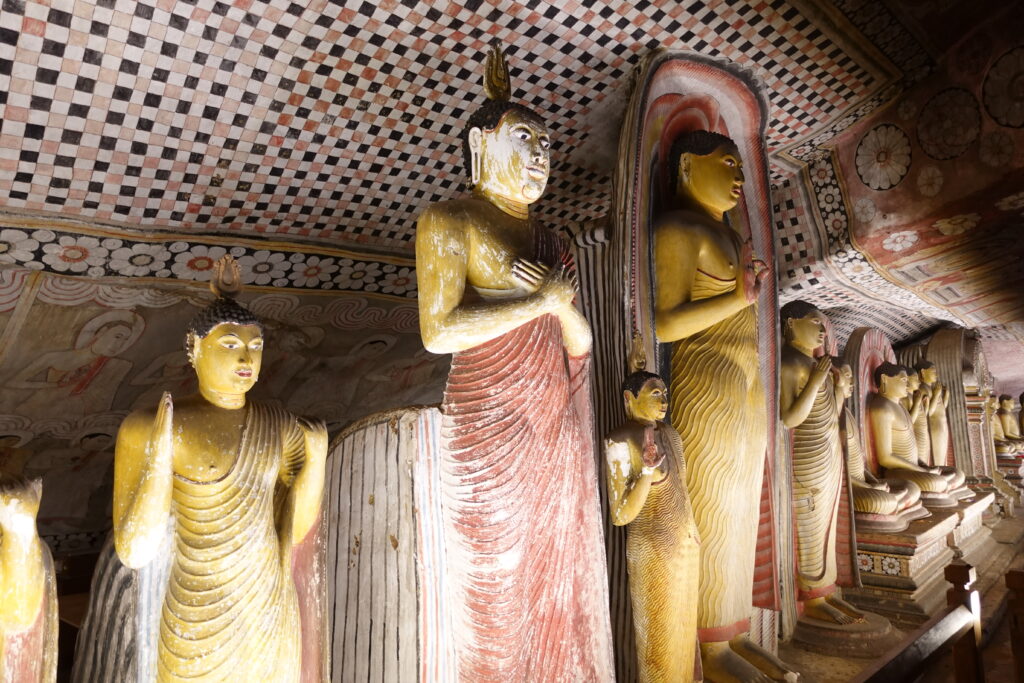
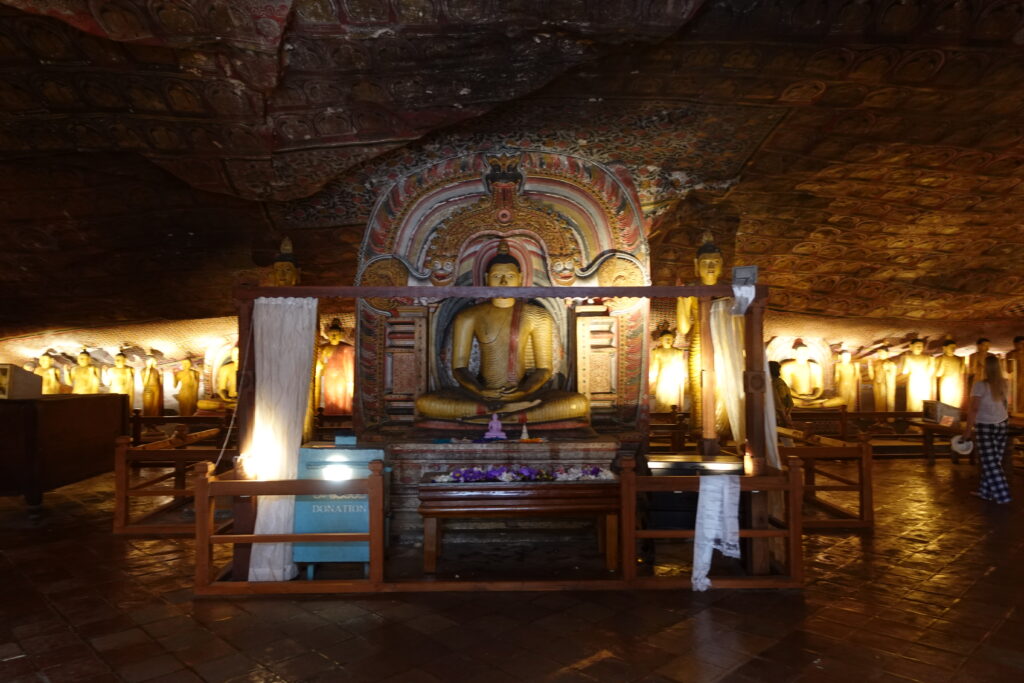
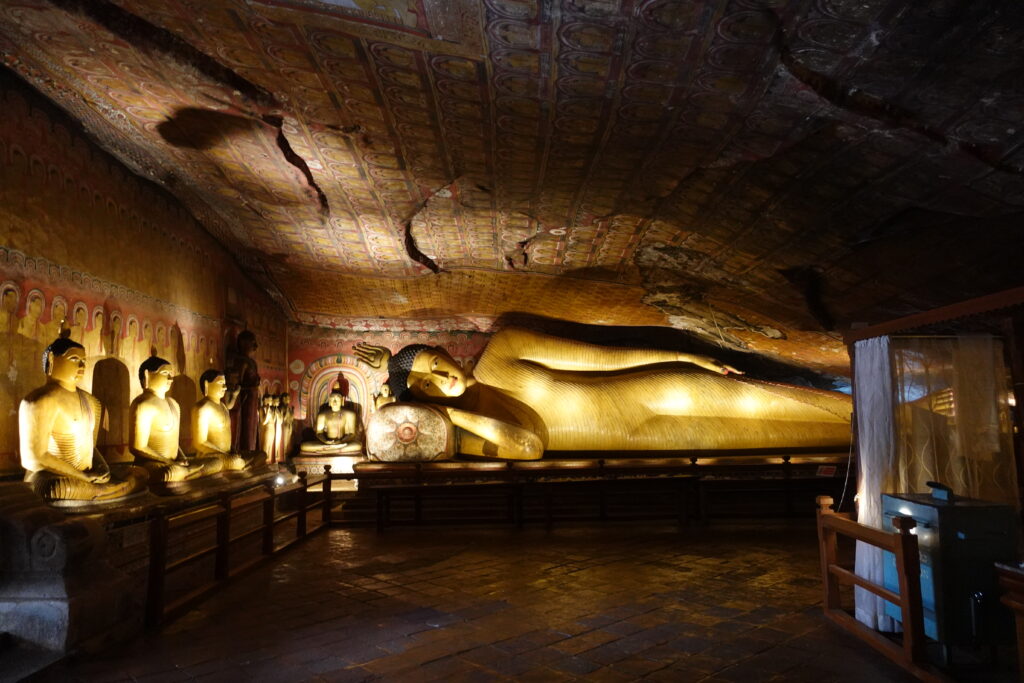
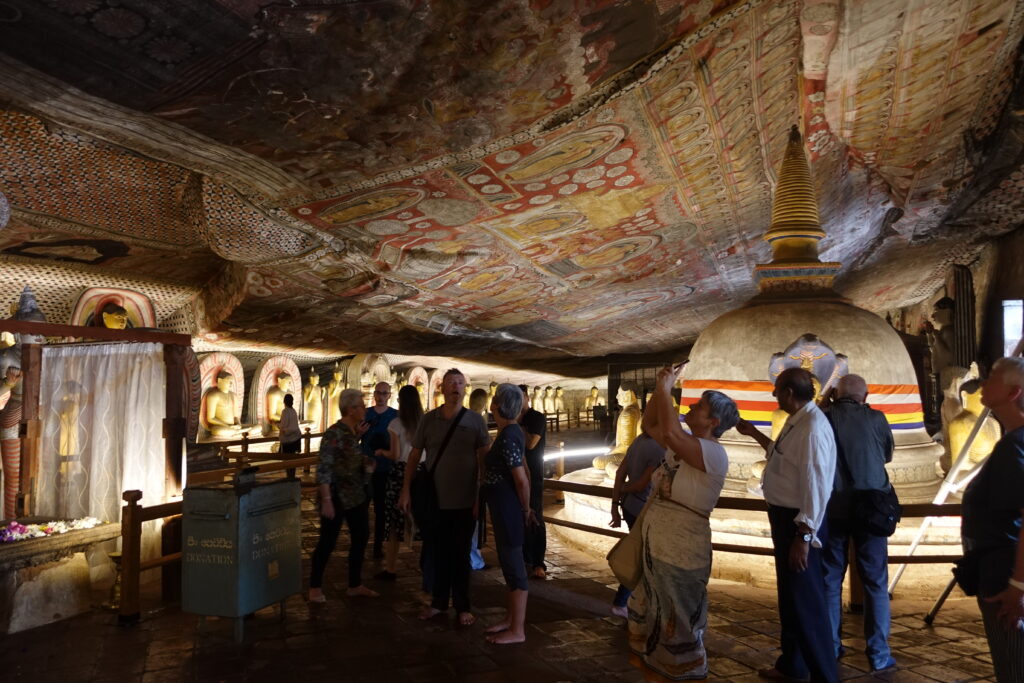
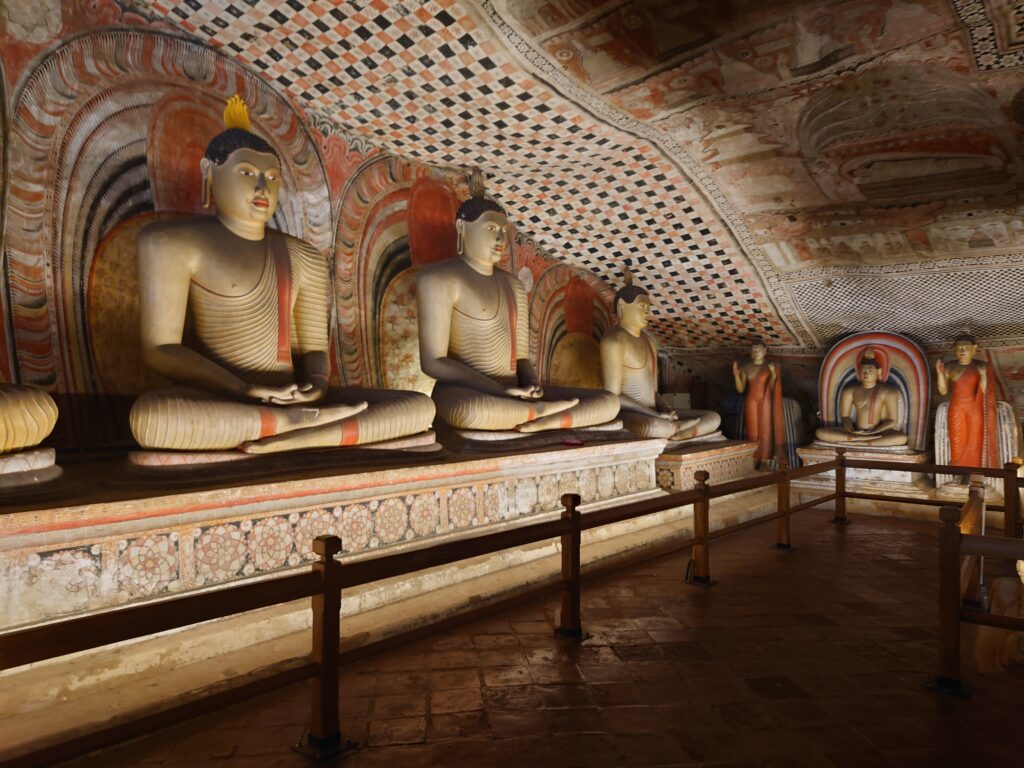
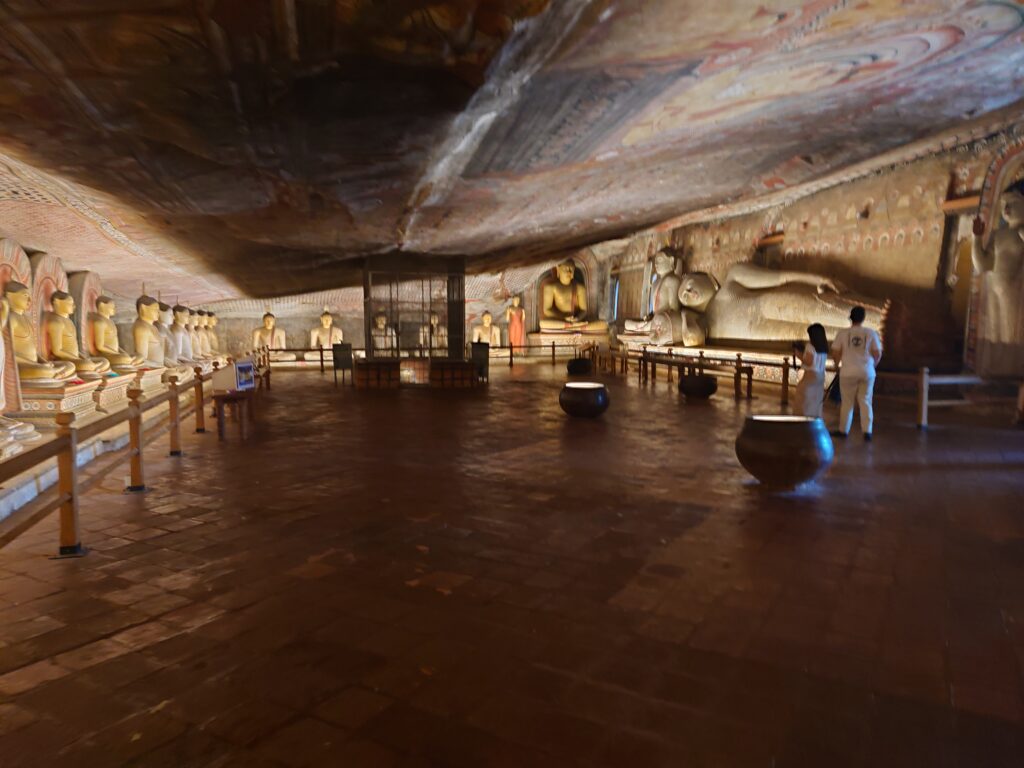
But being in this grotto, I can't help but think.
Let's be honest.
Dambulla is my "Number 1 Disappointing World Heritage Site". I have seen many World Heritage sites, historical buildings, and sacred places, but never have I been so disappointed. In a sense, I can say that it was shocking.
As I have said many times, this is probably partly because I have come to know the history of Sri Lankan Buddhism. Not to mention the fact that I have no Sri Lankan context, but I could only sense something "arbitrary" in this grotto. I could clearly see Sinhala Buddhist nationalism. I could not just say, "Wow, it's beautiful.
Of course, we know that the current interior of the Dambulla Grottoes is based on the 17th and 18th centuries during the Kingdom of Kandy. Sinhala Buddhist nationalism did not yet exist in this period. Therefore, I am not disappointed with the grottoes themselves. I was disappointed in the way it was displayed and the way it should be.
Sorry Sri Lankans, but this is what I think is the honest truth. I am not denigrating Sri Lankan culture. This is just my personal opinion. If Sri Lankans came to Japan, they would have many things to think about. I believe that it is important to assert differences of opinion in order to get to know each other.
The Dambulla Grottoes have become unforgettable for me. I would like to recommend it to others. I don't know how many people will be as shocked as I was, but I would like you all to experience it for yourselves. In a sense, it was the most shocking World Heritage Site in Sri Lanka.
*Below is an article with reference books on India and Sri Lanka that we have referenced in this travelogue. Please refer to them.
periodA list of recommended reference books to help you learn about Indian history, religion, and culture."
periodA list of recommended books for "those who want to know more about Indian Buddhism."
periodA list of recommended books to help you get to know the Buddhist country of Sri Lanka."
Next Article.
Click here to read the previous article.
Related Articles











